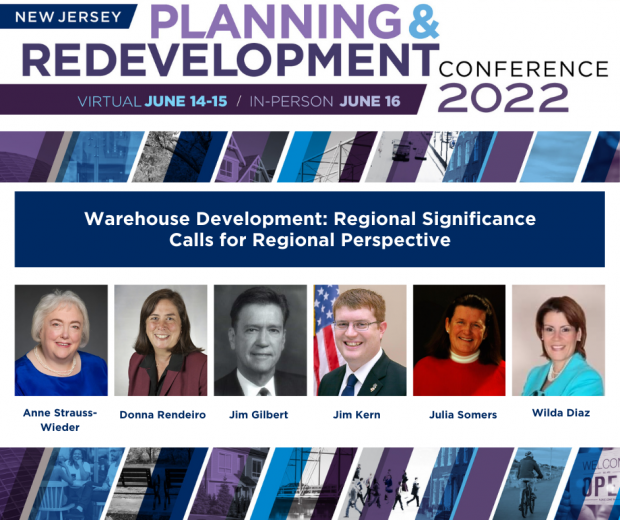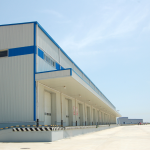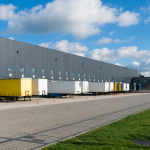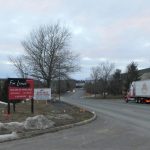New Jersey Future Blog
Warehouse Development: Regional Significance Calls for Regional Perspective
July 11th, 2022 by Tim Evans
 Industries devoted to the movement and storage of goods are a pillar of New Jersey’s economy, providing jobs to nearly one out of every eight employed New Jersey residents. Growth in e-commerce and in the volume of international trade arriving at the country’s second-busiest port, the major facilities of which are located in North Jersey, are creating unprecedented demand for warehouse space. At the 2022 NJ Planning and Redevelopment Conference—hosted jointly by New Jersey Future and the New Jersey chapter of the American Planning Association—a session titled Warehouse Development: Regional Significance Calls for Regional Perspective drew attention to the importance of the industry, and offered advice to towns scrambling to figure out how to deal with warehouse development proposals.
Industries devoted to the movement and storage of goods are a pillar of New Jersey’s economy, providing jobs to nearly one out of every eight employed New Jersey residents. Growth in e-commerce and in the volume of international trade arriving at the country’s second-busiest port, the major facilities of which are located in North Jersey, are creating unprecedented demand for warehouse space. At the 2022 NJ Planning and Redevelopment Conference—hosted jointly by New Jersey Future and the New Jersey chapter of the American Planning Association—a session titled Warehouse Development: Regional Significance Calls for Regional Perspective drew attention to the importance of the industry, and offered advice to towns scrambling to figure out how to deal with warehouse development proposals.
Jim Gilbert, a member of New Jersey Future’s Board of Trustees and a former chair of the State Planning Commission, served as the session’s moderator and started off the discussion by noting that the surge in demand for warehouse space is creating a host of problems that have caught state and local leaders off guard: unanticipated demands on transportation facilities, loss of farmland, and disruptions to urban areas, among other concerns that land-use decision-makers are confronting.
The big news to come out of the session is that the Office of Planning Advocacy (OPA), which serves as the staff for the State Planning Commission, has issued guidance (viewable on their website under the heading “Reference Materials”) that is designed to help local leaders better understand the goods movement industry so they can make more informed decisions about where to site warehousing facilities. Donna Rendeiro, the executive director of OPA, provided an overview of the guidance and discussed how OPA can assist local decision makers with updating their planning and zoning to incorporate and reflect the information provided in the guidance.
Not all warehouse proposals have the same set of land-use and transportation needs or are appropriate for the same kinds of sites, a fact not well understood by local officials or residents who oppose warehouse development. To shed some light on how the industry works, Anne Strauss-Wieder, director of freight planning at the North Jersey Transportation Planning Authority, elaborated on the different types of warehouse buildings. Warehouses can range from the behemoths that receive goods coming off giant cargo ships and distribute them to smaller warehouses across the eastern half of the country to the local delivery centers from which the ubiquitous UPS or Amazon vans are dispatched to deposit packages at their final destinations, effectively performing the same role as local shopping centers but without the inbound car traffic.
Strauss-Wieder also touched on the types of vehicles that the different types of facilities tend to attract, an important consideration as to where a given facility might best be located relative to the transportation network. The OPA guidance has a section devoted to the hierarchy of buildings involved in goods movement and storage.
The larger facilities that are involved in wide-scale distribution of entire shiploads of goods tend to want to locate as close to the port as possible. But the older urban centers that surround the major port facilities in Elizabeth, Newark, and Bayonne are often also home to “overburdened communities,” neighborhoods characterized by high percentages of people of color or lower-income households. Because many of these neighborhoods have historically experienced a variety of environmental stressors, the legacy of New Jersey’s industrial past, the pollution emitted by the steady stream of trucks accessing the warehouses can represent a much more significant cumulative impact here than elsewhere. The OPA guidance has a section on air quality and health impact considerations, to draw attention to these cumulative impacts and recommend against locating certain kinds of goods-movement facilities in these neighborhoods.
This is not to say that warehouse development cannot offer positive outcomes to urban communities, however. Wilda Diaz, former mayor of Perth Amboy, described how a warehouse proposal provided her city with the opportunity to clean up a contaminated site formerly occupied by an abandoned steel mill. As part of a comprehensive agreement with the City that included numerous improvements (e.g. roads, stormwater infrastructure, implementation of green and sustainable initiatives), the warehouse developer mitigated the environmental hazards on the property, turning a polluted eyesore into a new source of tax revenue for the city and a source of employment for nearby residents–an important benefit for the municipality with the highest unemployment rate in Middlesex County. What’s more, the developer’s improved connections to the local street network enable some local residents to walk to work—especially important in a place where many households can’t afford cars—while allowing trucks to access the regional highway network in the other direction without having to travel on local streets. Diaz explained that communicating the potential benefits of the project via a public outreach campaign was important in overcoming negative perceptions, and that negotiating the benefits agreement with the developer was key to getting buy-in from the surrounding community.
Warehouses pose a different set of problems in more outlying locations. Julia Somers, executive director of the New Jersey Highlands Coalition, mentioned the risk of paving over important groundwater recharge areas in the Highlands, which are traversed by Interstates 78 and 80, two of the major arteries feeding into the port areas in North Jersey. The stretches of Warren and Hunterdon counties along I-78 are also home to some of the state’s prime farmlands, which can also be attractive to warehouse development because of proximity to the highways and lower land prices than at closer-in locations. New Jersey is a leading nationwide producer of certain fruit and vegetable crops, so when agriculture and warehousing compete for the same land parcels, it sets up a conflict between two industries of statewide importance, a conflict that may not be optimally resolved by leaving the decision to the local unit of government.
Warren County commissioner Jim Kern, as both a former mayor and now a county official, spoke to the need for regional coordination. He talked about New Jersey’s “home rule” system that invests municipal governments with power over land-use decisions and how the promise of property-tax revenue often leads towns to court development that may have negative effects on the environment or local quality of life, both within the host municipality and in surrounding jurisdictions. Somers pointed out that in other cases municipalities zone land for industrial use as a sort of placeholder, mainly to prevent it from being developed as housing, and are unprepared when a commercial developer proposes to actually build a warehouse on it, an example of the “be careful what you wish for” phenomenon.
As an example of what higher levels of government can bring to the table, Kern cited a Light Industrial Site Assessment that Warren County completed in 2020 that provided an overview of sites in the county that were zoned for warehousing and illustrated how many such sites were located next to roads that were not up to the task of accommodating truck traffic. In urban areas, concerns focus on trucks passing through residential neighborhoods while in rural areas the issue is two-lane roads that were not built to handle big trucks, but both situations illustrate the need to consider transportation networks when siting warehouses, which local governments may not be best equipped to do. The OPA guidance has a section intended to educate local officials about this issue.
In general, the OPA guidance is designed to offer a statewide perspective on warehousing, covering a broad set of issues. In the coming months, New Jersey Future will be reviewing the guidance and looking for ways that it can be institutionalized in state agency policies and practices, and we will be exploring the potential of its proposal for county-level technical advisory committees as a vehicle for bringing together the perspectives of multiple stakeholders as inputs into the warehouse siting process. We applaud the OPA guidance as a critical step toward a more systematic approach to accommodating growth in one of the state’s key industries.
Related Posts
Tags: Development, Economic development, environmental justice, New Jersey planning and redevelopment conference, warehouse, warehouse growth, warehouse sprawl, warehousing
















